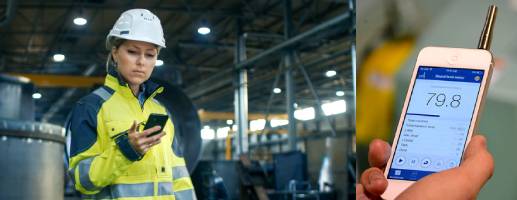Center for Direct Reading and Sensor Technologies

The NIOSH Center for Direct Reading and Sensor Technologies (NCDRST) coordinates research and develops recommendations on the use of 21st century technologies in occupational safety and health. The NCDRST is a virtual center hosted by the NIOSH Health Effects Laboratory Division and the NIOSH Exposure Assessment Core and Specialty Program ,and has consolidated activities in the National Occupational Research Agenda Manufacturing Sector Council, the Center for Motor Vehicle Safety, Center for Work and Fatigue Research, and the Total Worker Health program.
Respirable Dust Sensor Technology
NIOSH researchers have developed several direct-reading methods and real-time monitors and they are constantly exploring new ways to use these technologies to improve occupational safety and health. A few examples include technologies developed for mining environments to monitor respirable dust, the continuous personal dust monitor and the Helmet-CAM approach and complementary EVADE software, crystalline silica with the field-based RCS monitoring approach and the FAST software and the proximity detection sensors to address the co-presence of workers and machines in confined spaces.
Real-time Monitoring of Airborne Contaminants
Monitoring ultrafine aerosols and their chemical composition in real-time using portable handheld instruments is now possible using Aerosol Mobility Spectrometers and Quantum Cascade Laser-IR & Raman analyzers. Sensor arrays, like the Portable Electronic Nose Sampler (MSEM) can allow visualization of different dimensions using modeling and training techniques.
Smartphone Sensors
NIOSH has also developed two smartphone applications that use sensors. The first, the Sound Level Meter App, is a tool to measure sound levels in the workplace. It also provides noise exposure parameters to help reduce occupational noise-induced hearing loss. The second, the Ladder Safety App, helps users set their extension ladder at the proper angle, among other features. Ladders are one of the leading causes of falls.
Direct-reading methodologies and sensors are being used more and more frequently for health and safety in many workplaces: including mining, oil and gas, manufacturing, and construction. Both direct-reading methodologies and sensors are useful to detect and monitor hazardous conditions, to assess and document intervention strategies, and especially to immediately trigger alarms in the event of unsafe conditions. Generally, these technologies can provide timely information to users and, in the case of sensors and real-time monitors, additional valuable data within the monitoring session as opposed to traditional time-delayed monitoring methods.
The use of sensors to improve safety and health has increased exponentially as countless remote wireless systems are now employed for monitoring the environment, work sites, disaster response, “smart” buildings and facilities. Wireless data transfer based on cell phone networks and smart phone technology is enhancing the adoption of these sensors and allowing integration of geographically disperse sensors to produce comprehensive exposure maps. Wearable and even implantable sensors are being developed and they will aid in exposure assessment and clinical practice.
The NCDRST contributes to the following NIOSH Strategic Plan for FYs 2019-2023 goals that seeks to better understand the use of direct-reading and sensor technologies:
Sector
Sector
Sector
Intermediate Goal
Intermediate Goal
Intermediate Goal
Agriculture Forestry and Fishing
Sector
Agriculture Forestry and Fishing
Construction
Sector
Construction
Healthcare and Social Assistance
Sector
Healthcare and Social Assistance
Manufacturing
Sector
Manufacturing
Mining
Sector
Mining
Oil and Gas Extraction
Sector
Oil and Gas Extraction
Public Safety
Sector
Public Safety
Services
Sector
Services
Intermediate Goal
The Center for Direct Reading and Sensor Technologies Performance One-Pager (PPOP) offers a snapshot of NIOSH programs’ priorities, strategies used to make progress towards priorities, recent accomplishments, and upcoming work.
Topic Page
More information and useful resources can be found on the Direct reading and Sensor Technologies Workplace Safety and Health Topic Page
Contact
NIOSH invites your participation in any aspect related to direct-reading methodologies and real-time monitors to improve the health of workers and the public. Please contact the NCDRST at sensors@cdc.gov with any questions.
